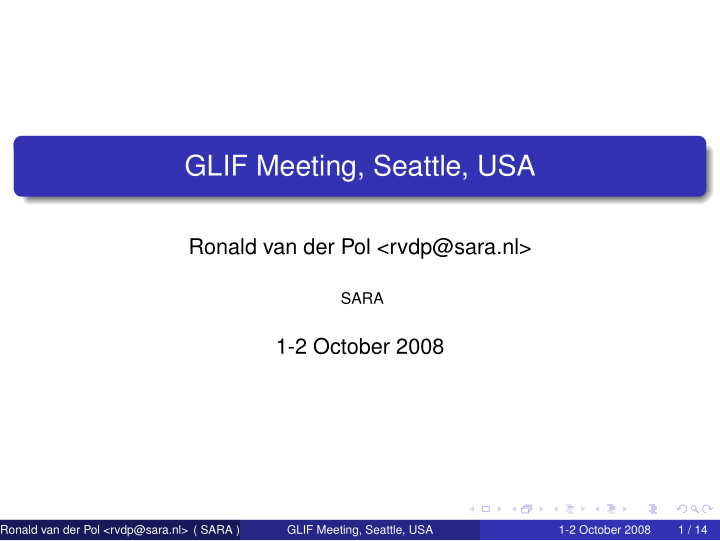



GLIF Meeting, Seattle, USA Ronald van der Pol <rvdp@sara.nl> SARA 1-2 October 2008 Ronald van der Pol <rvdp@sara.nl> ( SARA ) GLIF Meeting, Seattle, USA 1-2 October 2008 1 / 14
Outline Introduction 1 About the Global Identifiers Task Force Why Do We Need Global Identifiers? Requirements 2 Naming Schemes 3 DANTE Naming Scheme Internet2 Naming Scheme Sourcing Organisation Naming Scheme URN Naming Scheme Naming Scheme Recommendation 4 Discussion Issues 5 Questions about Global ID Semantics Resulting Operational Procedures for Lightpaths Summary 6 Ronald van der Pol <rvdp@sara.nl> ( SARA ) GLIF Meeting, Seattle, USA 1-2 October 2008 2 / 14
Global Identifiers Task Force The task force was established during the GLIF meeting in Honolulu (January 2008). Members of the task force: Ronald van der Pol, SARA (leader) Lars Fisher, NORDUnet Tom Lehman, USC ISI Thomas Tam, Canarie Ronald van der Pol <rvdp@sara.nl> ( SARA ) GLIF Meeting, Seattle, USA 1-2 October 2008 3 / 14
Why Do We Need Global Identifiers? Many GLIF lightpaths cross multiple domains. Network operators need a way to uniquely identify interdomain lightpaths. during provisioning when announcing planned work on a lightpath during outages Current pratice is to use local domain identifiers in trouble tickets. Every domain uses different a name for the same lightpath Very time consuming and error prone to map foreign local identifiers to you own local identifiers Note: Global IDs do not replace local IDs. Global IDs are just aliases Each domain is free to continue to use its own local naming scheme internally Ronald van der Pol <rvdp@sara.nl> ( SARA ) GLIF Meeting, Seattle, USA 1-2 October 2008 4 / 14
Requirements Prefered format: DomainPart-LocalPart . DomainPart: unique domain identifier LocalPart: set by the domain to a unique string Centralized registries should be avoided. A maximum length of the identifier should be set. Well-defined character set. Ronald van der Pol <rvdp@sara.nl> ( SARA ) GLIF Meeting, Seattle, USA 1-2 October 2008 5 / 14
DANTE Naming Scheme The DANTE naming scheme is used in the LHCOPN and DEISA networks. Example: CERN-TRIUMF-LHCOPN-001 Each domain has a unique identifier Each project has a unique identifier Global name consists of end site domains, project and sequence number Ronald van der Pol <rvdp@sara.nl> ( SARA ) GLIF Meeting, Seattle, USA 1-2 October 2008 6 / 14
Internet2 Naming Scheme The Internet2 naming scheme is used in Internet2. The identifiers are called Global Resource Identifiers (GRIs). Example: dcn.internet2.edu-6811 Initiating domain constructs the name by: domain id: DNS style name of initiating domain service instance id: unique number generated by initiating domain Ronald van der Pol <rvdp@sara.nl> ( SARA ) GLIF Meeting, Seattle, USA 1-2 October 2008 7 / 14
Sourcing Organisation Naming Scheme This is a variant of the Internet2 naming scheme. Example: starlight:chi-van-42 Sourcing organisation identifier instead of DNS style name as first part Sourcing organisation sets second part Second part is unique within the domain Ronald van der Pol <rvdp@sara.nl> ( SARA ) GLIF Meeting, Seattle, USA 1-2 October 2008 8 / 14
URN Naming Scheme Uniform Resource Names (URNs) are defined in RFC 2141. The format of URNs is: <URN> ::= "urn:" <NID> ":" <NSS> Example: urn:glif:starlight:chi-van-42 < NID > is set to glif < NSS > is similar to second part of Sourcing Organisation Naming Scheme Ronald van der Pol <rvdp@sara.nl> ( SARA ) GLIF Meeting, Seattle, USA 1-2 October 2008 9 / 14
Naming Scheme Recommendation Many people seem te prefer a naming scheme that includes information about the organisation that has more information about the lightpath. The Internet2, Sourcing Organisation and URN naming schemes comply with this. A discussion about the semantics of global identifiers has started. Ronald van der Pol <rvdp@sara.nl> ( SARA ) GLIF Meeting, Seattle, USA 1-2 October 2008 10 / 14
Questions about Global ID Semantics Hierarchy or flat namespace? Do we want information about end sites in the Global ID? Do we want information about sourcing organisation in the Global ID? Useful during outages? (indicates who to contact, saves time?) Do we want information about a lookup service in the Global ID? Or is a Global ID just a key for a lookup service? Central or distributed lookup service? Do GOLE operators need a lookup service? Or is it just a key to their local information systems? Ronald van der Pol <rvdp@sara.nl> ( SARA ) GLIF Meeting, Seattle, USA 1-2 October 2008 11 / 14
Resulting Operational Procedures for Lightpaths We need to start using the Sourcing Organisation concept. How do we handle tickets for planned work and outages? How about: Domain that has the planned work or outage informs the sourcing organisation Sourcing organisation informs all domains along the path and the end users When does a global identifier change? How about: Rerouting does not change the global ID as long as the end-points stay the same Rerouting is: A-B-C-D to A-E-C-D Change in interface change of link between two nodes Ronald van der Pol <rvdp@sara.nl> ( SARA ) GLIF Meeting, Seattle, USA 1-2 October 2008 12 / 14
Summary There is an operational need for Global Identifiers. The Internet2 and URN like naming scheme seem to get most support. During provisioning we need to start following the Sourcing Organisation model. Next we need to work on operational procedures (planned work, outages). Ronald van der Pol <rvdp@sara.nl> ( SARA ) GLIF Meeting, Seattle, USA 1-2 October 2008 13 / 14
Discussion Ronald van der Pol <rvdp@sara.nl> ( SARA ) GLIF Meeting, Seattle, USA 1-2 October 2008 14 / 14
Recommend
More recommend